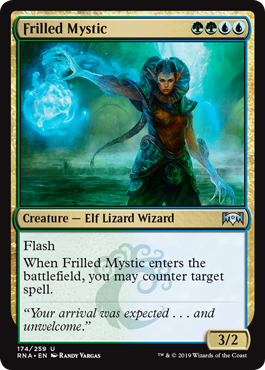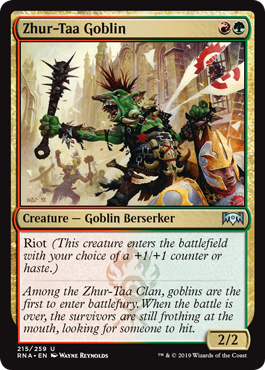Boros - The Value of a Tick
Tempo is a subject people can argue about basically whenever someone wants to start a Twitter fight. The most useful metric I've found for it is making it discrete. The concept of a “tick” is getting a tangible play ahead. If you Take Heart to win a three drop combat then play another creature, that's a tick ahead.
Due to the playable depth of Guilds of Ravnica, you often had to make decisions about what spells you wanted in your Boros deck. Two of the common borderline cases were Command the Storm and Sure Strike. You often hear things like “Sure Strike is basically removal in this format”, but conceptually what causes that is hard. It isn't just a format being fast or slow, that would be too easy.
Back to the tempo discussion, the upside of Sure Strike is that it often puts you up a tick. It costs two and can slot in with another play where Command the Storm just won't.
Boros just made it very clear what the value of that tick was due to Mentor, and also the flatter creature sizing. Getting ahead a tick in Boros was almost always putting you ahead a tangible attacker for turns. That pushed Sure Strike ahead of Command the Storm in most scenarios, with sideboard options for Izzet non-blocking races or Dimir too much removal for tricks scenarios.
This valuation is basic in game “do I use my trick” stuff. In future formats, it should be “do I value this in draft and deck build” from the start. Can you get a tick ahead with the trick, and looking ahead what does that tick of value produce?
Selesnya - Play to the Pieces, Even Cogs
Really early on, everyone figured out Selesnya Convoke didn't work. Then we all figured out Selesnya is green Boros. You make a bunch of cheap creatures and battle with combat tricks, maybe convoking one or two larger things.
I’ll take this minute to scoreboard, as I had this down from the first week as evidenced by my first draft at Grand Prix Montreal. The trick is to not just build around the payoffs, but build around the enablers or cogs you are given. Obviously your first instinct is going to be trying to cast Siege Wurm, but when that fails you have to take a step back to the other pieces.
A theoretical example from the upcoming Ravnica Allegiance format. Maybe the payoffs for +1/+1 counters aren’t great, but there are a number of reasonable adapt creatures. These are cards that pay you off for a slightly longer game and not trading as much early, as well as having instants as you can adapt at instant speed. A Simic deck could find itself with a defensive slant with counterspells, utilizing adapt to maximize the number of large late game bodies it plays without clunking out too much. This might even promote an Azorius splash. And look, Frilled Mystic is the Simic hard to cast uncommon and it points to this instant speed countermagic strategy! Think like this, and you will find a lot more lanes open up to you in a draft than you expected.
Three or Five Color - Why It Failed
True multi-colored decks were scarce in Guilds of Ravnica. The only reliable one was Grixis, usually Dimir splashing Hypothesizzle, and besides that it was mostly a loose splash on half of Status // Statue or a mythic rare. Looking back six years ago at Return to Ravnica and Gatecrash, we saw three colors be fine in Return to Ravnica but utterly fail in the aggressive Gatecrash. The Crackling Drake cycle has something to do with this set, but we can look at how it was similar to Gatecrash and see more reasons.
Putting together the past examples, I think the main thread is how important two and three drops are to your deck, especially multi-colored ones. The constraint on being one guild or splashing is just how much you can afford to be missing one of your colors on turn two or three. Selesnya and Boros largely couldn't. Their two drops were much better on time than a turn late, and they were evenly split between the colors. Goblin Electromancer on the other hand was a fine later play if you were immediately getting a one mana rebate on another spell, and Dimir just didn't care about two drops, allowing the Grixis merger to be clean.
Watch for this especially in Gruul in Ravnica Allegiance. If the guild is about slamming three and four drop riot monsters at your opponent, consider a splash. Orzhov could go down a similar road depending on if afterlife is used as an aggressive tool to keep value on wide attacks or as a defensive tool to grind opponents down. Simic is already pointing towards a slower deck that probably can afford a splash as per previous, and you probably don't need a hint on where Azorius and Radkos fall on the curve out to control scale. Overall I expect Ravnica Allegiance to be a lot more splash friendly than Guilds of Ravnica, but we will see when the full set is previewed soon!
Three or Five Color - Why It Failed
True multi-colored decks were scarce in Guilds of Ravnica. The only reliable one was Grixis, usually Dimir splashing Hypothesizzle, and besides that it was mostly a loose splash on half of Status // Statue or a mythic rare. Looking back six years ago at Return to Ravnica and Gatecrash, we saw three colors be fine in Return to Ravnica but utterly fail in the aggressive Gatecrash. The Crackling Drake cycle has something to do with this set, but we can look at how it was similar to Gatecrash and see more reasons.
Putting together the past examples, I think the main thread is how important two and three drops are to your deck, especially multi-colored ones. The constraint on being one guild or splashing is just how much you can afford to be missing one of your colors on turn two or three. Selesnya and Boros largely couldn't. Their two drops were much better on time than a turn late, and they were evenly split between the colors. Goblin Electromancer on the other hand was a fine later play if you were immediately getting a one mana rebate on another spell, and Dimir just didn't care about two drops, allowing the Grixis merger to be clean.
Watch for this especially in Gruul in Ravnica Allegiance. If the guild is about slamming three and four drop riot monsters at your opponent, consider a splash. Orzhov could go down a similar road depending on if afterlife is used as an aggressive tool to keep value on wide attacks or as a defensive tool to grind opponents down. Simic is already pointing towards a slower deck that probably can afford a splash as per previous, and you probably don't need a hint on where Azorius and Radkos fall on the curve out to control scale. Overall I expect Ravnica Allegiance to be a lot more splash friendly than Guilds of Ravnica, but we will see when the full set is previewed soon!


No comments:
Post a Comment
Note: Only a member of this blog may post a comment.